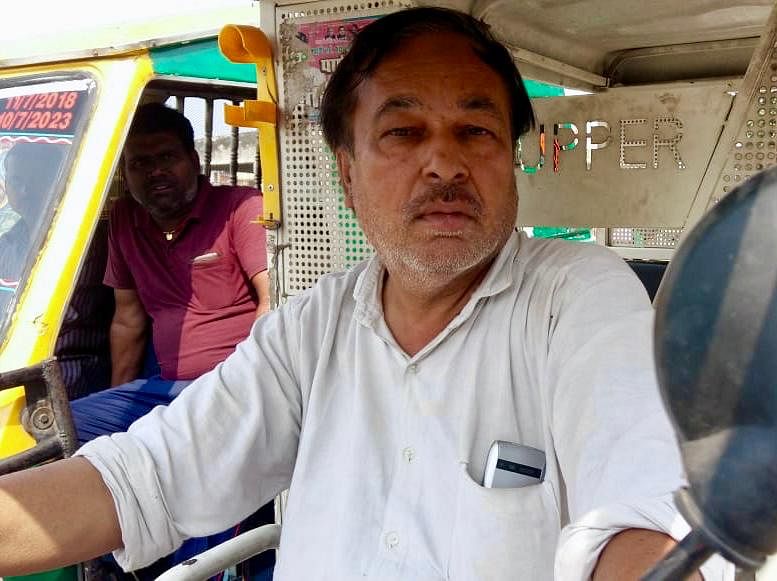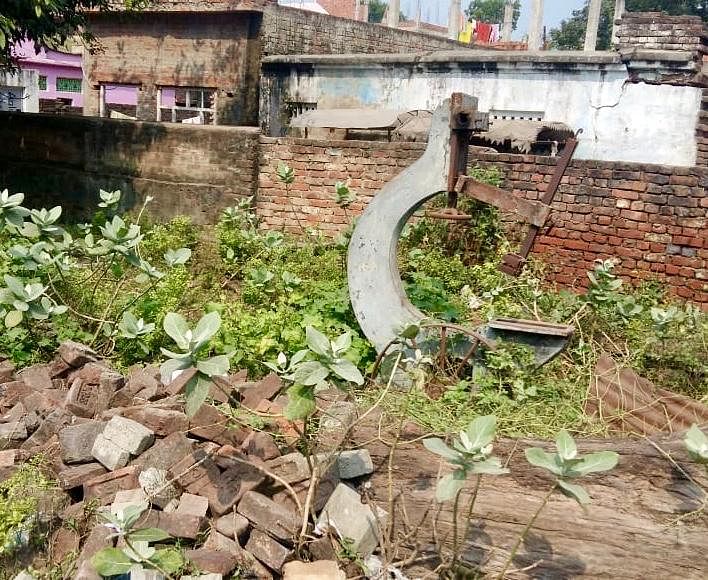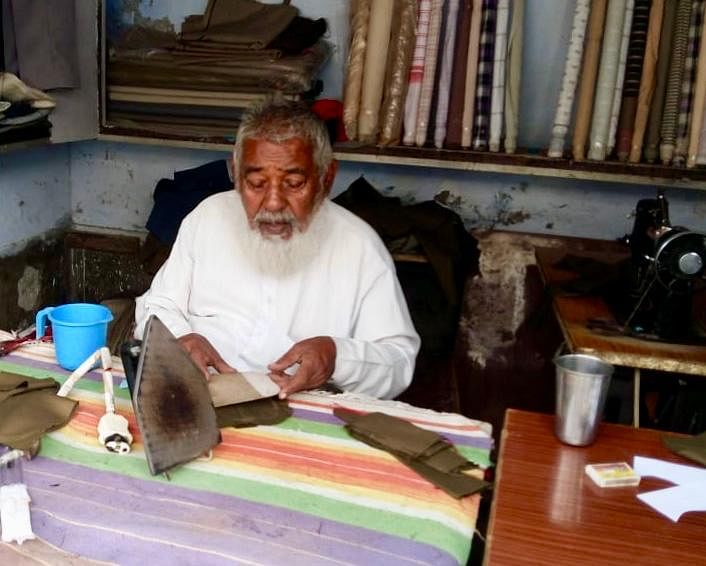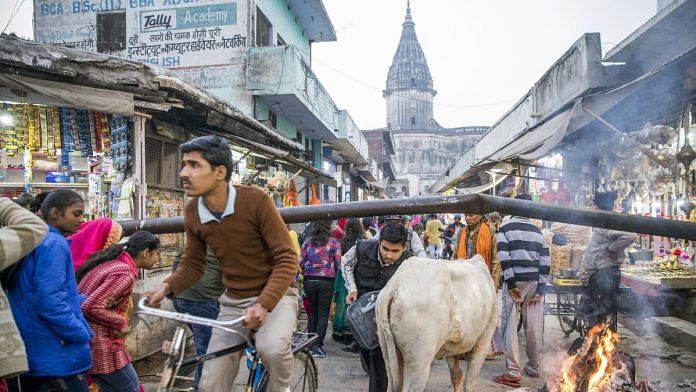Haji Abdul Gaffar was the last imam of the Babri Masjid, till one night in 1949 an idol of Ram Lalla was secretly placed under its central dome and the district administration allowed a priest to perform his daily puja.
“Ayodhya means a place without war, but I knew that this act would lead to bloodshed not just here but across the entire Awadh region, which we consider Ram’s Janmabhoomi, and even outside,” Imam Haji Abdul Gaffar had told me a few months before the demolition of the Babri Masjid on 6 December 1992 by thousands of freshly-minted Ram bhakts, who called themselves karsevaks.
Mobilised by organisations owing allegiance to the RSS, the VHP, the Bajrang Dal, the Shiv Sena and the BJP, the karsevaks claimed the 16th-century mosque was built by Mir Baqi, a general in Mughal emperor Zahir-ud-din Muhammad Babar’s army, after razing a Vaishnav temple. It was not just any temple, but one that they believed marked the precise spot where Ram was born.
The following year, the Narasimha Rao government acquired 67 acres of land surrounding the disputed site, including the 2.77 acres on which the Babri Masjid had stood, turning the heart of Ayodhya into a heavily armed fortress.
Now, 70 years after Haji Abdul Gaffar was locked out of the Babri Masjid following Ram Lalla’s ‘miraculous’ appearance inside its premises, the Supreme Court will give the final verdict on the title claims, which will determine whether a temple, a mosque, or both will be built on the contested 2.77 acres of land.
Also read: Ram-Ram Chhodo, Jai Shri Ram Bolo: How Ayodhya erased Sita
‘No redressal or sympathy’
Since the return of the BJP to power at the Centre in 2014 and in the state in 2017, Nritya Gopal Das, president of the Ramjanmabhoomi Nyas that was set up in 1993 to oversee the construction of the proposed Ram Mandir, has been convinced that the mandir’s time has come. This has made Shahid, the grandson of Haji Abdul Gaffar, even more anxious as the judgement day approaches.
“My grandfather died a broken man, but Allah was kind to take him away a few days before the Babri Masjid was demolished. But two of his sons, my father Mohammed Shabir and my uncle Mohammed Nazeer, were not so fortunate. They were chased and hacked to death by a mob of triumphant karsevaks the same night, right outside our house on the main Faizabad-Ayodhya road,” Shahid, who was 22-years old then, said.

The house and the family-owned sawmill were burnt down. Nearly three decades later, the scraps of rusted metal peeking through the wild grass and piles of brick and rotting wood are still visible.
“We lost timber and machinery worth Rs 10-15 lakh but received just Rs 2 lakh as compensation for the death of my father,” says Shahid who is the eldest of the eight siblings in the family. Over the years, he repeatedly tried to restart the sawmill, but the state forest department refused to issue a new license: they wanted proof of ownership, which was destroyed in the arson.
“Our papers permitting the purchase of wood, income and sales tax receipts, registration documents were all reduced to ashes, but there was no redressal or sympathy,” says Shahid. In desperation, Shahid, the scion of one of Ayodhya’s most educated, prosperous and old families, turned to driving auto-rickshaws and e-cycles on the roads of Ayodhya and Faizabad to make a living. Today, it’s his only source of income.
“Sixteen Muslims were killed in Ayodhya in the aftermath of the demolition. The police conducted their post-mortem and the administration arranged for their burial. But till today, there has been no investigation into the violence, no one was ever questioned or booked, not even when the Samajwadi Party and the Bahujan Samaj Party, accused by the BJP of being pro-Muslim, were in power,” recalls Sheetla Singh, former editor of the local daily Jan Morcha.
Shahid wants justice for his father, uncle and grandfather. “If we give up our claim, it will be a betrayal of his (grandfather’s) memory and our faith. Had the demolition not been accompanied by hatred and violence, maybe I would have felt less victimised,” he says.
‘The fear never leaves us’
And that is the real tragedy of Awadh – the historical name of the region where Ayodhya is located. Many Hindu shrines are built on the land donated by Muslim aristocrats, like Hanumangarhi, Ayodhya’s biggest temple. Or the Sundar Bhavan, which was built by a royal family from the neighbouring district of Basti, but managed by Munnu Mia, a devout Shia, till his death.
It was this same syncretic culture that underlined the friendship between Hashim Ansari, the original Muslim litigant in the Ramjanmabhoomi title suit, and Ramchandra Paramhans, the flamboyant head of the Digambar Akhara who led the temple movement till his death in 2003. Bitter adversaries in court, they forgot their differences outside.

But Shahid sends his wife and children to stay with relatives in the neighbouring district of Gonda whenever there is a scent of trouble in Ayodhya. “Every year on 6 December, karsevaks pass through our area raising slogans against Muslims, asking us to go to Pakistan; the fear never leaves us,” he says.
Also read: No matter what SC decides on Ayodhya, the assertive Hindu is here to stay
‘We grew distant, something was lost’
But 78-year-old Waliullah Khan or Lala tailor, as he is popularly known, is not going anywhere.
Waliullah’s shop-cum-residence – four half-built rooms with a tin roof – stands adjacent to the disputed site. Raised from the ashes, after everything he owned was looted and burnt in the mayhem that followed the demolition.
It was also the first time I had met him, on the morning of 7 December 1992, as he stood helplessly, eyes fixed on the flames greedily licking his home. Waliullah and his family survived the attack only because a Hindu neighbour gave them shelter. “I always enjoyed a good relationship with the Hindus of Ayodhya. They got their clothes stitched from me, I purchased my groceries from their shops. We felt safe with each other. But the religious and political leaders who came from outside, riding their raths and brandishing their trishuls created such a vicious atmosphere that it came to this,” Waliullah had said at the time.
The father of six, who has lived in Ayodhya all his life, felt insecure for the first time in 1986, when former Prime Minister Rajiv Gandhi ordered unlocking of the gates of the Babri Masjid for public darshan to counter charges of Muslim appeasement by the Congress party’s high-caste Hindu constituency. Ram Lalla was, with one swift stroke, thrust into the nation’s political consciousness, setting the stage for the rise of Hindutva and the start of the Ramjanmabhoomi agitation. In October 1990, thousands of karsevaks for the first time descended on the temple town along the banks of the Sarayu river, seeking to destroy the Babri Masjid — 16 were killed in police firing.
“Till then, there was hardly any security presence in Ayodhya, but overnight it began to resemble a conflict zone,” recalls Waliullah. In the following decades, as Ayodhya got used to the new normal, the temples continued to depend on local Muslims for Ram’s needs, the flowers offered in his puja and the dresses he wore – but the two communities stopped trusting each other.
“We grew distant, even though I still have several Hindu customers,” he once told me. “No one is openly hostile, but when people start avoiding you, it becomes clear how they feel. Something was lost, just like the gentler, age-old greeting of ‘Jai Siya Ram’, which was replaced by the more strident cry of ‘Jai Shri Ram’,” he had said.

‘Everyone here feels suffocated’
Meanwhile, as change swept India, making it one of the world’s fastest-growing economies, Ayodhya remained trapped in the Mandir-Masjid conflict.
Its residents have been forced to live with broken roads, choked sewers and lack of doctors. No government in Lucknow has attempted to develop Ram’s janmabhoomi, while the dispute has dragged on in court.
But not once in the past 27 years has Waliullah ever said that he wants to move out of the town where he was born, even though it feels like a prison. “There is a barrier in every street. No one can walk in Ayodhya with their heads held high. The police will raise the barrier only for VIPs, we are always bending down. Everyone here feels suffocated,” he says.
Still hard at work on his sewing machine, he admits his body is tiring, his eyes are becoming weak and he would like nothing more than to see the old ghosts of history being laid to rest. To him, any solution is acceptable as long as it brings peace.
But the wise tailor of Ayodhya also knows that no decision can be made in haste. “Even if a nail drops in Ayodhya, its sound reverberates across India,” he says.
Also read: Has Supreme Court rushed through Ayodhya case or was it the only way to achieve closure?
The author is an independent journalist. Views are personal.




Hindutva terrorists did not fight for independence. They just waited on sidelines and cooperated with British as Muslims and Hindus fought for independence.
Now BJP RSS call themselves patriots using all the development done by gandhi Nehru , sardar Patel ( who hated RSS) , moulana Azad and other non BJP RSS governments
Peace between Hindus and Muslim can happen under the following conditions: (1) Muslims should completely give up their wet dreams of Gazwa-e-hind by population jihad.
This will never happen, India has always been, will always remain mainly Hindu, dharmic country. Demographic change by over breeding will not be tolerated, necessary action will be taken. You have already doubled from 7% to 14%, we will not tolerate any more. (2) Muslim should abandon unnecessary aggression and antagonism against Hindus. (3) Stop playing the minority card, everybody is equal, you are Indian first practice your religion within the four walls of your home. (4) Stop idolizing Mughal and muslim invaders – they are enemies of India. (4) Join the mainstream, don’t isolate yourself saying you are different. (5) Accept you have Hindu ancestry, you are not Arabs, Turks, Iranians.
Do you know what happened in Iran in 1979 how a liberal progressive country turned into regressive beliefs narrow-minded country
Hindus/India came victorious of 1000 years of invasion against uncivilized cultures of the west. All great civilizations could not withstand these invasions like Egypt Persia Mayans but we are the only one. The uncivilzed people has tendency to convert places of worship of another cultures/religion to their own. All the 3 great mosques were stolen and occupied from other religions. So Hindus should not have demolished the structure like they did in 1992 but should have done in a civilized way as we did for Somnath. Show values of Ram to them and not of looters like Babur
Peace is more important than anything else. Hope the present decision of the SC starts an atmosphere where peace can be established and nurtured. Only peace can make India grow as a fastest growing economy leading to 5 trillion dollar size. Otherwise we may have to keep our fingers crossed.
Why Print doesn’t allow up or down vote or recommend to readers comment?
Because , like Maggi Hot n Sweet sauce, they think thye are different. On a serious note, I too wonder why. Have written to them before – no response.
What happened to this poor family is an abomination it makes my blood boil more than the Babri Masjid demolition.
India’s 180 million Muslims are angry and there reaches a breaking point.
This is too big a population for discrimination against permanently.
Muslims are a proud people with a rich culture, they will eventually be a reckoning.
A house divided within itself will fall.
Fascist ideologies promise everything, but just as in Nazi Germany evil begets great suffering eventually, the Indians who voted for thugs will eventually have these thugs bring about the destruction of them and the country.
To all Indian Muslims I say, this too will pass, but prepare yourself for a great struggle.
Try whatever u and ur ummah, will get final solution this time, if u or ur brothers try doing anything stupid this time. There is no MK Gandhi to save u either this time, so stop giving empty threats and ask ur brethren to mend their ways.
Coward!!
Its is scum like you using words like ‘final solution’ that threw the babies into the fire and organised pogroms against minorities. You ilk organised riots in order to garner the vote.
The hand of all good men will strike down the evil in you and in your Parcharak.
This RSS hoodlum Openly threatening a ‘final solution’ for Muslims, In the comment section,
this is what INDIA has become under the Pracharak, This fellows guru, Savakar also called for the elimination of Muslims and sent the RSS during partition into Jummu which resulted in 200,000 deaths and the ethnic cleansing of an entire population out of Jummu into Pakistan.
These are truly evil people INDIA would have been undivided if it was not for them, now they will divide India again.
@Abhi, well said and I am coming for Final solutions to muslim problem!
You can never come to solution of muslims and ummah. we were the fighters rulers and peace makers and we are all over the world. for so long years it was our time we ruled but we did not clense ethnicly. today it is ur time you can threaten, harass but cannot convert or etnically cleanse all even with any conspiracy or evil plans. muslims are peace lovers who will shed their own blood with patience but will never bough down. so stop your nonsense of threat. we are not endangered religion and will never be.
So called liberal writers like Trivedi , write these so called nuanced article which gives out their thoughts of why precisely what India has become after independence. These so called English speaking elite have destroyed our culture so much by not adhering to any tenets of our culture that we are now paying a very heavy price for this. No country in the world which majority population of either christians or muslims bash their own religion like the English speaking elites of India do to their own religion. They have completly destroyed our Indian culture by constantly downgrading on the masses of our country…
It is an accepted practice to use uppercase for referring a deity or a prophet in third person as He or She. Hope the author will follow this norm in her next dispatch.
This is Jinnah’s legacy. India was divided on religion and Pakistan was created for Muslims. Millions of Indian Muslims who voted for Pakistan did not go there. Pakistan and Bangladesh systematically reduced their Hindu population. And today Bangladeshi Muslims are coming to India to earn their livelihood. And Sindhis and Baloch wants freedom from Punjabis. Mohajirs do not care if Pakistan is broken again. Was the division of India really necessary then?
Very good answer. It’s stupid infight of congress and Nehru’s undeserved ambition with Gandhi’s support lead to today.
There were no Muslims or Christian in India but came and took over the nation. Now majority has taken back some lost ground.
Hindus are kind and forgiving, most peace loving in the world but Muslims can’t live peacefully with their own.
No Sindhis no baluchis want freed, this is a false disinformation propaganda that people from any region in Pakistan want secession. Pakistan was united, is United and will get even more United and strong whereas India is on verge of destruction . 100 plus independent movements in 450 districts running in India be it khalistan movement, seven sister state movements ( Nagaland, Manipur, Assam, Maoists e.t.c) .
Please worry about India splitting into many independent parts …this is your future !
Pakistan ZINDAAABAAD !
Broken roads, choked sewers, lack of doctors. Chuck in a somnolent economy. That is our Utopia. The Golden Age promised to us in the epics.
Yes. Nehruvian utopia. The best examples being UP’s constituencies that have been unfailingly loyal to the Nehru-Gandhi dynasty. One would have expected at least these places to become shining beacons of hope, showcasing the best that ‘Nehruvian liberalism, democracy and development’ had to offer. Instead they have become basket cases, living examples of how not to do things.
How true!! Talk Rae Bareli and Amethi separately from Yogi’s UP. Well, SP and Congress were not enemies; Akhilesh JI was a ‘bright young politician’ (according to admirers) and Shrimati Sonia JI was almost the empress of India. Who’s complaining? Either those Congress loyalists burning with jealousy (bad losers) or those who wanted a ‘broken’ coalition to replace the corrupt UAP II. Just keep listening to their logic and you will notice the contradictions that emerge in their comments.
Yes. Even after Muslim invaders looted and destroyed their most sacred temple and built a mosque (which was called masjid-e-janmasthan) on its foundation to show religious domination, even after centuries of trauma and struggle to reclaim their beloved janmasthan, even after overhwhelming archeological, literary evidence proving the continuous in-habitation of the site since millennium BC, its the Muslims who are the victims.
Muslims want to dominate others wherever they are, even where they are a small minority.
it was not called masjid e janmasthan and it is not on foundation refer o real facts then fabricated ones.